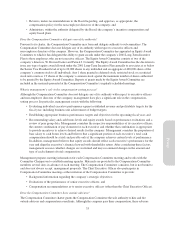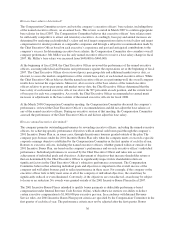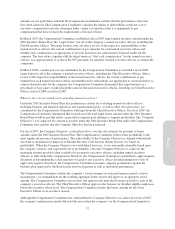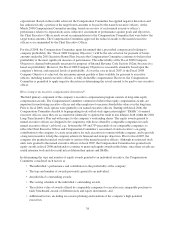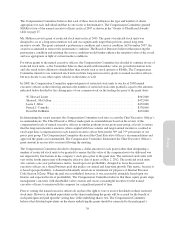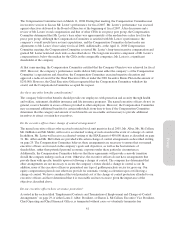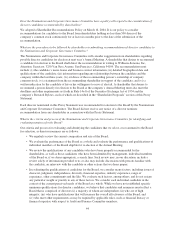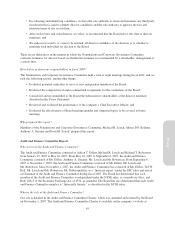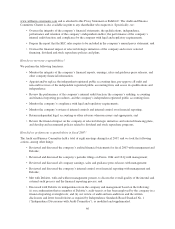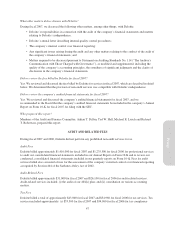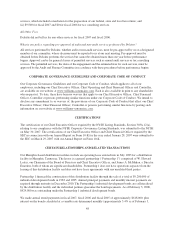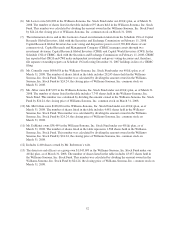Pottery Barn 2007 Annual Report Download - page 132
Download and view the complete annual report
Please find page 132 of the 2007 Pottery Barn annual report below. You can navigate through the pages in the report by either clicking on the pages listed below, or by using the keyword search tool below to find specific information within the annual report.employment for good reason, she will be entitled to certain severance benefits. The Compensation Committee
believes these arrangements are necessary to ensure that these two senior executives are focused on the
company’s goals and objectives as well as the best interests of shareholders rather than potential personal
economic exposure under these particular circumstances.
Also, the restricted stock units that were granted to the company’s named executive officers in fiscal 2005 vest in
full upon a termination due to the death, permanent disability or retirement of such named executive officers after
attaining age 55 and working with the company or the company’s subsidiaries for at least 10 years. The
Compensation Committee believes these conditions to be prevalent in the retention award agreements of
similarly situated executives.
Finally, as described above, if Mr. Lester ceases service due to death or disability or upon a change of control,
the SSAR award granted to him on January 12, 2007 will vest in full. The Compensation Committee believes that
these provisions are necessary to ensure that the CEO is focused on the company’s goals and objectives as well
as the best interests of shareholders rather than potential personal economic exposure under these particular
circumstances.
Otherwise, the named executive officers do not have arrangements that provide them with specific benefits upon
their termination. The Compensation Committee has considered the total potential cost of the severance benefits
to the executive officers and determined them to be reasonable and not excessive.
Do we provide perquisites to the executive officers?
The company provides executive officers with perquisites and other personal benefits that the company and the
Compensation Committee believe are reasonable and enable the company to attract and retain superior
employees for key positions.The company provides certain perquisites to its named executive officers, including
premiums for term life insurance in excess of $50,000, a matching contribution for investments in our 401(k)
plan, a $500 monthly car allowance and an annual executive medical supplement of up to $2,500. Some of these
perquisites are also provided to other employees. In addition, Mr. Lester occasionally makes personal use of the
company aircraft. The value of all of these benefits to each of the named executive officers is detailed in the
“Other Annual Compensation from Summary Compensation Table” on page 24. The Compensation Committee
believes these perquisites to be customary for comparable professionals in our industry based on their
management and retail industry experience. There were no material changes to the perquisites provided to the
named executive officers in fiscal 2007.
The named executive officers who contribute to our 401(k) plan receive matching contributions from the
company up to a maximum of $5,625 (in fiscal 2007), as do all participating employees earning over $225,000.
The named executive officers may also defer salary and short term incentive amounts into a nonqualified
deferred compensation plan. There is no company contribution to the nonqualified deferred compensation plan;
the executives are offered only the opportunity to delay tax inclusion from one year to another. The
Compensation Committee believes this benefit is prevalent among similarly sized companies.
How does the Compensation Committee address Internal Revenue Code Section 162(m)?
Under Section 162(m) of the Internal Revenue Code of 1986, as amended, and regulations adopted under it by
the Internal Revenue Service, publicly held companies may be precluded from deducting certain compensation
paid to certain executive officers in excess of $1,000,000 in a year. The regulations exclude from this limit
performance-based compensation, SSARs and stock options, provided certain requirements, such as shareholder
approval, are satisfied. Exceptions to this deductibility limit may be made for various forms of “performance-
based” compensation. The company believes that awards granted under the company’s equity incentive plans
qualify as performance-based compensation and can therefore be excluded from the $1,000,000 limit. We believe
that bonuses awarded to date under the 2001 Incentive Bonus Plan also qualify as performance-based
compensation and are excluded from calculating the limit. While we cannot predict how the deductibility limit
42



